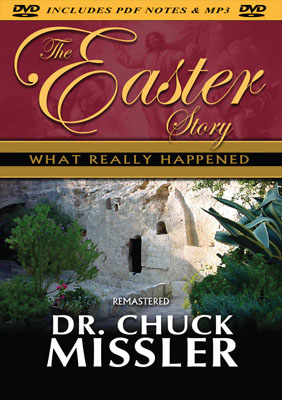Most reasonably informed Christians are well aware that many of the traditions that surround the Christmas holidays have pagan origins and very little correlation with the actual events as recorded in the Bible. However, most of us are surprised when we discover that some of what we have been taught about “Easter” is not only in error, but deliberately so!
Many, of course, are aware that the name “Easter” actually originates with the pagan worship of Ishtar (or Astarte) that was traditionally observed at the time of the vernal equinox, nominally about March 21 or 22. Traditional pagan fertility symbols of both rabbits and eggs continue to be associated with this holiday.
However, the name as commonly used is also currently associated with the events surrounding the Crucifixion and Resurrection of Jesus Christ, which actually occurred on the Jewish Passover and is clearly defined in the Scriptures as the 14th of Nisan.
The Quartodeciman Controversy
It may come as a shock to learn that the early church deliberately committed to separating itself from the explicit record of Scripture. The practice of those Christians insisting on celebrating Passover on the fourteenth day of Nisan from the Old Testament calendar1 was known as Quartodecimanism (“fourteenism,” as derived from Latin).
It is nothing short of astonishing to discover that not only was this was a major emotional controversy within the early church,2 but that the commitment to deviate from the Scriptures was driven by a deep anti-Semitism!
The controversy surrounding this issue was a principal topic at the Council of Nicea in 325 a.d. Emperor Constantine presided over this council—note his own words:
It was, in the first place, declared improper to follow the custom of the Jews in the celebration of this holy festival, because their hands having been stained with crime, the minds of these wretched men are necessarily blinded ... Let us, then, have nothing in common with the Jews, who are our adversaries ... avoiding all contact with that evil way ... who, after having compassed the death of the Lord, being out of their minds, are guided not by sound reason, but by an unrestrained passion, wherever their innate madness carries them ... a people so utterly depraved ... Therefore, this irregularity must be corrected, in order that we may no more have any thing in common with those parricides and the murderers of our Lord ... no single point in common with the perjury of the Jews.3
The early church father, Eusebius, also records Emperor Constantine as writing:
... it appeared an unworthy thing that in the celebration of this most holy feast we should follow the practice of the Jews, who have impiously defiled their hands with enormous sin, and are, therefore, deservedly afflicted with blindness of soul ... Let us then have nothing in common with the detestable Jewish crowd; for we have received from our Saviour a different way.4
Setting a Date for Easter
The council unanimously ruled that the Easter festival should be celebrated throughout the Christian world on the first Sunday after the full moon following the vernal equinox; and that if the full moon should occur on a Sunday, and thereby coincide with the Passover festival, Easter should be commemorated on the following Sunday. As a result of the Council of Nicea, and amended by numerous subsequent meetings, the formal church deliberately attempted to design a formula for “Easter” which would avoid any possibility of it falling on the Jewish Passover, even accidentally!
A principal astronomical problem involved was the discrepancy between the solar year and the lunar year, and thus, the Julian calendar then in use. Numerous alternatives for fixing the date of the feast were tried by the church but proved unsatisfactory, so Easter was celebrated on different dates in different parts of the world.
In 387, for example, the dates of Easter in France and Egypt were 35 days apart. About 465, the church adopted a system of calculation proposed by the astronomer Victorinus, who had been commissioned by Pope Hilarius to reform the calendar and fix the date of Easter. Elements of his method are still in use, although the Scythian monk Dionysius Exiguus made significant adjustments to the Easter cycle in the 6th century.
Refusal of the British and Celtic Christian churches to adopt the proposed changes led to a bitter dispute between them and Rome in the 7th century. Reform of the Julian calendar in 1582 by Pope Gregory XIII, through adoption of the Gregorian calendar, eliminated some of the difficulties in fixing the date of Easter and in arranging the ecclesiastical year. Since 1752, when the Gregorian calendar was also adopted in Great Britain and Ireland, Easter has been celebrated on the same day in the Western part of the Christian world.
The Eastern churches, however, which did not adopt the Gregorian calendar, commemorate Easter on a Sunday either preceding or following the date observed in the West. Occasionally the dates coincide; the most recent times were in 1865 and 1963.
In 1928 the British Parliament enacted a measure allowing the Church of England to commemorate Easter on the first Sunday after the second Saturday in April. Despite these steps toward a consolidation, Easter continues to be a “movable” feast.
In the church’s zeal to separate itself from the Biblical text, confusion has continued.
Friday or Wednesday?
Another controversy continues concerning “Good Friday.” While there are many scholars who continue to defend a Friday Crucifixion, there are many who find this doubtful, for at least three reasons:
- Jesus specified that there would be “three days and three nights”—His words—between the Crucifixion and the Resurrection;5
- Jesus went from Jericho to Bethany six days before Passover;6 that would require more than a “Sabbath day’s journey” to occur on the Sabbath if Passover was on a Friday;
- There were two Sabbaths between Passover and Sunday morning,7 including the Feast of Unleavened Bread, one of the seven high Sabbaths each year.
This is why many serious scholars believe the Crucifixion occurred “between the two evenings” on a Wednesday Passover, not on a Friday. Three days later—“the morrow after Shabbat after Passover,”8 the Feast of First Fruits, was, indeed, our First Fruits, discovered on that Sunday morning.
Other Issues
There are, of course, many other misunderstandings about the details surrounding those pivotal events.
They had not planned to take Jesus on a feast day, for fear of the Romans.9 The timing was controlled by Jesus Christ Himself. Even in the garden of Gethsemane, it was Jesus who was giving the orders.10
Every detail of the six trials that Jesus endured was illegal.11
Satan was hoping for a “righteous death,” which, in the Torah, was a death by stoning. But the Romans had removed the Jews’ right to capital punishment. The death by crucifixion was detailed in the Scriptures 700 years before crucifixion was invented.12
What Is “The Gospel”?
The “Good News” can be summed up in five words: Jesus died and rose again! (See 1 Corinthians 15:3-4.) Perhaps the greatest failure by most renderings of the events of those crucial days—even Mel Gibson’s remarkable movie, The Passion, is the portrayal of the Crucifixion as a tragedy: it wasn’t a tragedy, it was an achievement! Literally hundreds of specifications were fulfilled to accomplish a goal set before the foundation of the world.
Prophecies of the Final Week
There are many Old Testament prophesies quoted in the Gospels specifically about Jesus’ final week. Here’s a brief list:
- He would make a triumphal entry in Jerusalem (Zechariah 9:9, Psalm 118).
- He would be smitten like a shepherd (Zechariah 13).
- He would be betrayed for 30 pieces of silver (Zechariah 11:1-13 and Psalm 41:9).
- He would be given vinegar and gall (Psalm 69:21).
- They would cast lots for His garments (Psalm 22:18).
- His bones would not be broken (Exodus 12:46; Numbers 9:12; Psalm 34:20).
- His side would be pierced (Zechariah 12 and Psalm 22:16).
- He would die among malefactors (Isaiah 53:9, 12).
- His dying words were foretold (Psalm 22:1,31).
- He would be buried by a rich man (Isaiah 53:9).
- He would rise on the third day (Jonah 1:17; cf. Genesis 22:4 with Hebrews 11:19).
- His resurrection would be followed by the destruction of Jerusalem (Daniel 9, 11 and 12).
Furthermore, The Passion also failed to indicate the most important point: Who He was! He wasn’t just a great figure, a teacher, or a positive influence. He was the Creator-God, humbling Himself to become our Kinsman-Redeemer!
A Conjecture
The Bible is one book—it has an integrity of design. It may surprise you to learn there are more graphic details of the Crucifixion in the Old Testament than in the New. For instance, Psalm 22 is a description of what it was like to hang on the Cross as if it were dictated by Christ Himself (although it was written by David 800 years earlier). Isaiah 52:14 says that He would be beaten so badly He would no longer look human.
But there is another verse most people overlook. Isaiah 50:6 says, “I gave my back to the smiters, and my cheeks to them that plucked off the hair; I hid not my face from shame and spitting.” If I understand this verse correctly and if it was fulfilled on the Cross—and I believe it was—that means they ripped off his beard!
This is particularly vivid for me because many years ago, I worked for a company that had a large software department and the head of that department happened to have a very full beard. After working with him for over a year, he came to work one day with his beard shaved off. I would not have recognized him but for another employee who happened to call his name.
Maybe that’s why Mary in the garden didn’t recognize Jesus; she thought He was the gardener! Did He have a disfigured face and scar tissue where His beard had been ripped off?
Maybe that explains why two disciples could walk seven miles with Him and not realize who He was until they saw His nail prints that evening. Maybe that’s another reason some in the Upper Room were so terrified as He stood there among them. That could also be why John, at the seashore in Galilee, said, “We didn’t dare ask Him because we knew it was the Lord” (John 21:12).
This brings up another question. Does Jesus still bear the marks of His Crucifixion?
Zechariah 12:10 says, “They shall look on me whom they have pierced.” This would seem to indicate that He will indeed bear the scars forever. Some say that the only man-made things in Heaven will be His scars.
In Revelation 5:6, John is transported forward in time and sees the Seven-Sealed Book: “And I beheld, and, lo, in the midst of the throne and of the four living creatures, and in the midst of the elders, stood the Lamb as it had been slain.” I think Jesus still bears His marks. They are the marks of His humiliation, but they are also the marks of His glory.
I am reminded of a young mother whose face was badly disfigured. Her little girl was continually ridiculed by the children in school because of her mother’s appearance. (You know how cruel children can be.)
When the little girl was old enough, the mother explained to her that when she was a baby there was a dreadful fire in the apartment and, although the mother was able to save the little girl, the mother herself suffered very severe burns in the process. From that day on, the little girl was no longer embarrassed about her mother. Every time she looked into her mother’s face it was a reminder of just how much she was loved.
We know that the Crucifixion was far more than just a physical event. And I suspect that you and I will spend an eternity discovering what it really cost Him that we might be there with Him and that we might live. It’s very possible that when we look into His face, we too will be reminded just how much we are loved...
This article was excerpted from Chuck’s latest briefing, The Easter Story: What Really Happened. It will be released later this month on audio cassette, audioCD, DVD, and download.
Notes:
- Defined in Leviticus 23:5 to be a perpetual ordinance (cf. Exodus 12:14).
- Based on the writings of Irenaeus, the Roman church had celebrated Passover on a Sunday at least since the time of Bishop Xystus or Sixtus I, 115-125 a.d. (Eusebius H.E. 5.24.14). The aged Apostolic Father Polycarp visited Rome circa 154 a.d., at which time he discussed the difference in Paschal’s calculation with Bishop Anicetus and reached an amicable compromise. In addition, Polycrates of Ephesus and Irenaeus wrote in support of the Quartodecimans. (Eusebius H.E. 5.24.17).
- The Epistle of the Emperor Constantine, Theodoret’s Ecclesiastical History, 1.9.
- Eusebius, Life of Constantine, Book 3, chapter 18.
- Matthew 12:40.
- John 12:1.
- Matthew 28:1: ''sabbaton'' in the Greek text is a plural noun.
- Leviticus 23:15.
- Matthew 26:5.
- John 18:8.
- Over 20 specific infractions of legal procedure are detailed in our newest briefing package, The Easter Story: What Really Happened.
- Psalm 22; Isaiah 52:14-53:12; Zech 12:10.





